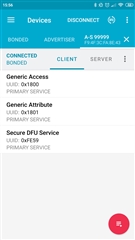Good afternoon,
I first devoloped my app based on the nRF52840 (SDK 15.2; S140 V.6.1.0) and it was perfectly working with or without bonds.
After that, and following what it is shown in this link (https://devzone.nordicsemi.com/nordic/nordic-blog/b/blog/posts/getting-started-with-nordics-secure-dfu-bootloader), I implemented Buttonless DFU funcntionality without bonds, and it was working fine. Now, I have tried to go ahead and doing the same DFU process with bonds, but application gets stuck when initializing DFU service: it gets stopped at 'ble_dfu_buttonless_init' function, when calling 'ble_dfu_buttonless_backend_init', and the result is 0x0008 (NRF_ERROR_INVALID_STATE). In order to test DFU with bonds, I have carried out the required modifications according to information specified in the link above:
Do you know which can be the reason of such error?
Best regards,
Dani.



